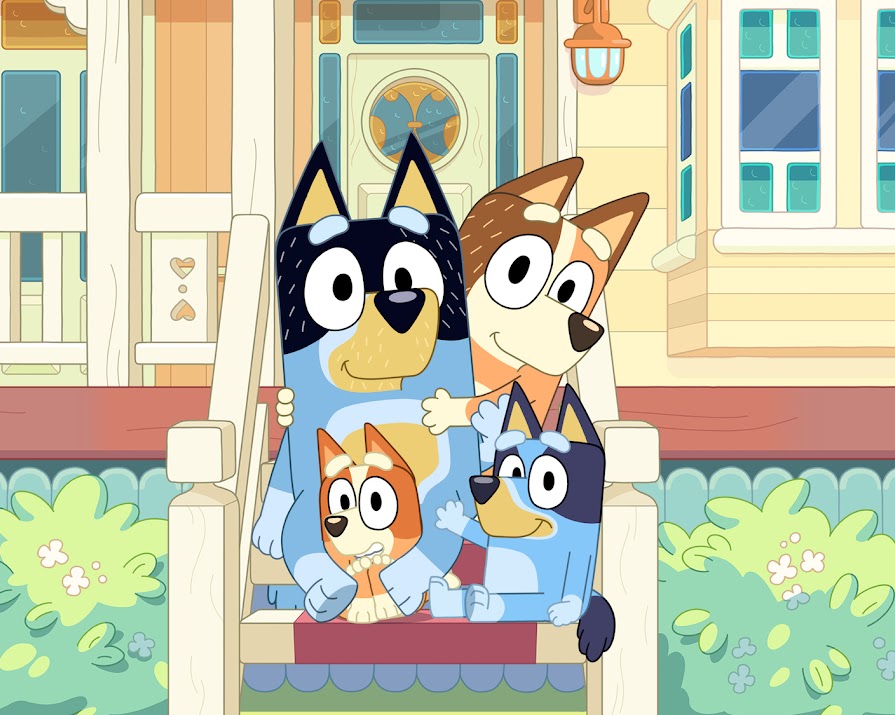By Rebekah Rainey
18th Apr 2024
18th Apr 2024
Dad (BANDIT), Mum (CHILLI), Bluey, Bingo (BLUEY'S SISTER).
With humour, sentimentality and a beautiful portrayal of the reality of parenting, it's no wonder everyone is asking "Did you see Bluey last night?"
Sometimes if I just even think about Bluey, I get this inexplicable lump in my throat. Like right now, my eyes are forming shallow puddles and I’m not quite sure why.
Whether you’re a parent or not, you’re likely to have at least heard of the Aussie pup Bluey by now. This week witnessed some monumental moments when it comes to a kid’s TV show – not only was the final episode trending on X (#BlueyTheSign) but parents gathered around their TV sets with arguably greater zest and anticipation than their children to watch the season “finale” of the cartoon.
IMAGE’s own editor Dominique McMullan acknowledged that “it must be the only kid’s TV show in history where people are talking about the season finale” and she was right. I found myself asking people “Did you see Bluey last night?” and while some people looked at me with a slightly bemused expression, others reassured me with excited eyes and the response “Yes, oh my God”.
So, what is it about Bluey that has both kids and parents at the edge of their seats? What made it the most-streamed TV show this year with 1.5 billion views in one week? What was it about that final episode that caused me and my five-year-old son to shed simultaneous tears?
Humour and sentimentality
If we consider the context of the show as a whole, there are a lot of factors that seem to separate it from its peers. The Australian cartoon-phenomenon first aired in 2018 and has only completed its third season which demonstrates a slower progression that is more on a par with a traditional TV series. Episodes are only seven-minutes long but each one is carefully crafted by writer Joe Brumm and takes four months to produce. That alone indicates a level of thought that I doubt any league of superhero puppies could rival. And unlike the never-aging characters in traditional TV animations, time passes by in Bluey. Both Bluey and Bingo have celebrated birthdays which allows viewers to grow alongside these characters – a nifty device that would certainly serve them in the short-term but has come to raise questions for the future of the show.
The series follows Bluey, a seven-year-old blue heeler dog, her younger sister, Bingo, their mum and dad, Chilli and Bandit, and their extended family and friends. There is nothing new in this premise and each episode follows a self-contained format much like any other children’s cartoon. Where it separates itself though is in the clever juxtaposition of humour and sentimentality – two integral drivers when it comes to human emotion.
They are not afraid to explore very adult themes but from a perspective that allows adults to reflect and children to touch on subjects from a safe distance. Bluey has episodes about typical challenges children face such as sharing and friendship but also explores concepts such as death, illness, infertility and marriage. They deploy powerful imagery that might give us a glimpse into complex themes such as PTSD but similarly that might just support a child learning to sleep on their own. The latter was covered in the “Sleepytime” episode which has been ranked as one of the greatest TV episodes of all-time by IMDB. There’s a reason for that – in a few short minutes they were able to resonate with both parents and children on an issue that affects them both so profoundly.
Cartoon support dogs
While Bluey would undoubtedly appeal to adults who are not parents, the hook of Bandit and Chilli and their aspirational parenting-style makes Bluey all the more relatable for caregivers. Psychologist, parent and fan of the show Carolyne Keenan asserts how “clever” the show is in its “portrayal of the reality of parenting.” While Director Daley Pearson recognises how the characters are the best of themselves, Keenan notes how “you also see the slight irritation and that classic pull of needing to do things for yourself even if your children want you all the time”. They are vulnerable, liable to the occasional swear-word (“duck-cake”) and, most importantly, as Keenan notes “they don’t always get it right”. Not only do they make parents feel less alone but they also give children a rare insight into how difficult parenting can be.
When I asked some parents why they loved Bluey so much, they all acknowledged the learning that it inspires – for their children and themselves. One father commented how they used the same tactic Bandit used to teach Bluey how to be patient; a mother explained how it left her feeling more positive about her role and capabilities as a parent; and another mum hit the nail when she said “I think it’s written for the kid that’s still a part of the adult and then for adult as they are now”.
I then asked my five-year-old why he loved it and he said “How should I know?” There’s something very poignant in that.
He would find himself giggling at their toilet jokes and aw’ing over Bingo unaware of the subliminal lessons he was being taught. Adults would chuckle at innuendos (the neutering reference springs to mind) while also feeling a sense of support offered through fictional cartoon dogs. I think of that episode where Chilli’s friend says to her “You’re doing great” and how, somehow, I felt like it was for me to hear.
The series finale, The Sign is another case in point as it explores change and how unsettling it can be for us all as the family plan to move house. What’s to come for Bluey, we don’t quite know yet – a movie, another series, an ending – but as the wise teacher Calypso reassured Bluey “everything will work out the way it’s supposed to”.
And while its return isn’t inevitable, I will always have the memories of enjoying Bluey with my Jude, even if he isn’t quite sure why he enjoys it.






















